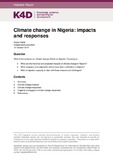Climate Change in Nigeria: Impacts and Responses
Abstract
Nigeria’s climate has been changing, evident in: increases in temperature; variable rainfall; rise in sea level and flooding; drought and desertification; land degradation; more frequent extreme weather events; affected fresh water resources and loss of biodiversity (see: Elisha et al., 2017; Ebele and Emodi, 2016; Olaniyi et al., 2013). The durations and intensities of rainfall have increased, producing large runoffs and flooding in many places in Nigeria (Enete IC, 2014). Rainfall variation is projected to continue to increase. Precipitation in southern areas is expected to rise and rising sea levels are expected to exacerbate flooding and submersion of coastal lands (Akande et al., 2017; Ebele and Emodi, 2016). Droughts have also become a constant in Nigeria, and are expected to continue in Northern Nigeria, arising from a decline in precipitation and rise in temperature (Amanchukwu et al., 2015; Olapido, 2010). Lake Chad and other lakes in the country are drying up and at risk of disappearing (Dioha and Emodi, 2018; Elisha et al., 2017). Temperature has risen significantly since the 1980s (Enete IC, 2014, 234; Federal Ministry of Environment, 2014). Climate projections for the coming decades reveal a significant increase in temperature over all the ecological zones (Akande et al., 2017). This rapid review synthesises evidence on the impact of climate change in Nigeria (geographic, sectoral, demographic and security impacts) and responses to address it (i.e. climate change mitigation and adaptation, adaptive capacity and capacity development). There are a few comprehensive reports and papers that provide useful evidence and discussion of the various impacts of climate change throughout Nigeria. The vast majority of the literature that provides evidence of climate change impacts and responses, however, focuses on the agricultural sector and on individual farming communities in particular regions of the country. Discussion of other mitigation and adaptation measures in the literature often takes the form of recommendations, rather than examples of what has already been achieved. This is likely due to the need for much greater implementation of mitigation and adaption measures in Nigeria. In addition, while there is some discussion about necessary capacity building at the individual, group and community level to engage in climate change responses, there is much less attention given to higher levels of capacity at the state and national level.
Citation
Haider, H. (2019). Climate change in Nigeria: Impacts and responses. K4D Helpdesk Report 675. Brighton, UK: Institute of Development StudiesIs part of series
K4D Helpdesk Report;675Rights holder
© DFID - Crown copyright 2019Collections
- K4D [937]

